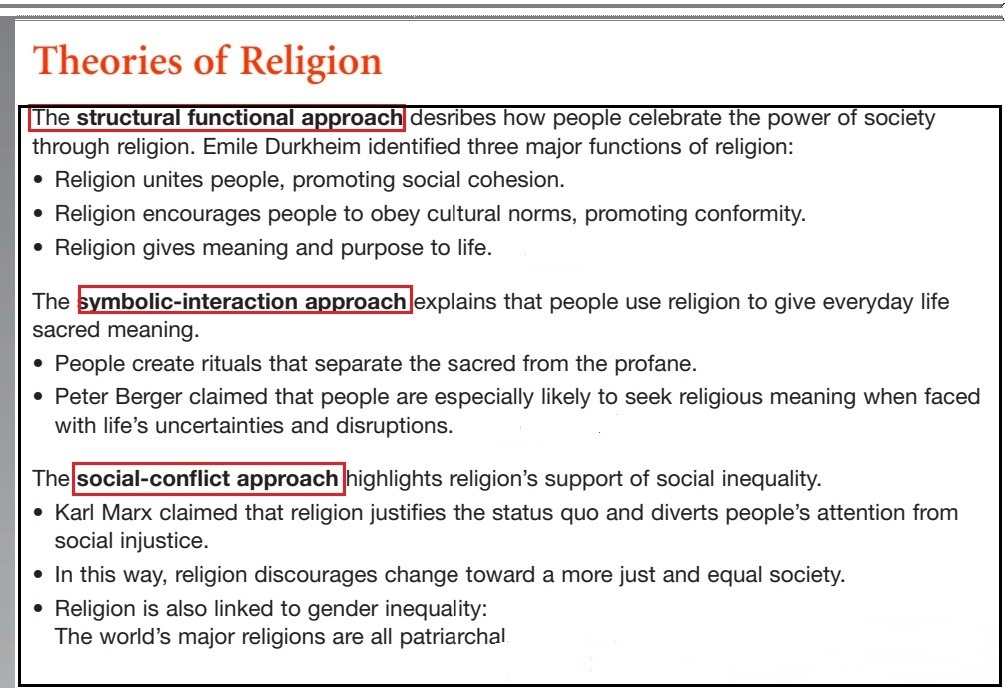What is Religion?
Religion is a social institution involving beliefs and practices based on recognizing the sacred. The French sociologist Emile Durkheim stated that religion involves “things that surpass the limits of our knowledge”.
We define most objects, events, or experiences as profane that include ordinary elements of everyday life. Contrary to that we also consider some things sacred, inspiring awe and reverence. Setting the sacred apart from the profane is the essence of all religious beliefs. There is great diversity in matters of faith, and nothing is sacred to everyone on Earth.
Jews believe that the Torah (the first five books of the Hebrew Bible or Old Testament) is sacred. Similarly, in the same way, Christians revere the Old and New Testaments of the Bible and Muslims exalt the Qur’an (Koran).
The Functions of Religion
- Much of the work of Émile Durkheim stressed the functions that religion serves for society regardless of how it is practiced or of what specific religious beliefs a society favors.
- Durkheim’s insights continue to influence sociological thinking today on the functions of religion. First, religion gives meaning and purpose to life. Many things in life are difficult to understand including the mystery of life and death. It is the religious faith and beliefs that help people understand the very existence of mankind and the meaning, origin, and purpose of life.
- Second, religion reinforces social unity and stability. This was one of Durkheim’s most important insights. Religion strengthens social stability in at least two ways.
- On one hand, it gives people a common set of beliefs and thus is an important agent of socialization while on the other hand, the communal practice of religion in Mosques, churches, and Temples, brings people together and strengthens their social bonds.
- Religion teaches people moral behavior and thus helps them learn how to be good members of society.
- The fourth function of religion is greater psychological and physical well-being. Religious faith and practice can enhance psychological well-being by being a source of comfort to people in times of distress and by enhancing their social interaction with others in places of worship. Many studies find that people of all ages, not just the elderly, are happier and more satisfied with their lives if they are religious. Religiosity also apparently promotes better physical health, and some studies even find that religious people tend to live longer than those who are not religious.
- Another function of religion is that it may motivate people to work for positive social change. Religion played a central role in the development of the Southern civil rights movement a few decades ago. Religious beliefs motivated Martin Luther King Jr. and other civil rights activists to risk their lives to desegregate the South. Black churches in the South also served as settings in which the civil rights movement held meetings, recruited new members, and raised money. 8. According to conflict theory, it can also reinforce and promote social inequality and social conflict. This view is partly inspired by the work of Karl Marx, who said that religion was the “opiate of the masses”.
Functions of Religion (Durkheim’s view)
Durkheim identified three major functions of religion that can tribute to the operation of society:
A)- Establishing social cohesion.
Religion unites people through shared symbolism, values, and norms. Religious thought and ritual establish rules of fair play, organizing our social life.
B)- Promoting social control.
Every society uses religious ideas to promote conformity. By defining God as a “judge,” many religions encourage people to obey cultural norms. Religion can also be used to back up the power of political systems. In medieval Europe, for example, monarchs claimed to rule by “divine right,” so that obedience was seen as doing God’s will. Even today, our leaders ask for God’s blessing, implying that their efforts are right and just.
C)- Providing meaning and purpose. Religious belief offers the comforting sense that our brief lives serve some greater purpose. Strengthened by such beliefs, people are less likely to despair in the face of change or even tragedy. For this reason, we mark major life-course transitions including birth, marriage, and death with religious observances.
Structural-Functional Analysis In Durkheim’s structural-functional analysis, religion represents the collective life of society. The major weakness of this approach is that it downplays religion’s dysfunctions, especially the fact that strongly held beliefs can generate social conflict. Terrorists have claimed that God supports their actions, and many nations march to war under the banner of their God. A study of conflict in the world would probably show that religious beliefs have provoked more violence than differences in social class. Symbolic-Interaction Analysis (social construction)
From a symbolic-interaction point of view, religion (like all of society) is socially constructed (although perhaps with divine inspiration). Through various rituals—from daily prayers to annual religious observances such as Easter, Passover, or Ramadan—people sharpen the distinction between the sacred and the profane.
Example Marriage is a good example. If two people look at marriage as merely a contract, they can agree to split up whenever they want. Their bond makes far stronger claims on them when it is defined as holy matrimony, which is surely one reason that the divorce rate is lower among people with strong religious beliefs. More generally, whenever human beings face uncertainty or life-threatening situations—such as illness, natural disaster, terrorist attack, or war—we turn to our sacred symbols.
Using the symbolic-interaction approach, we see how people turn to religion to give everyday life sacred meaning. Berger notes that the sacred’s ability to give special meaning to society requires that we ignore the fact that it is socially constructed. After all, how much strength could we gain from beliefs if we saw them merely as strategies for coping with tragedy? Also, this micro-level analysis ignores religion’s link to social inequality, to which we turn next.
Social-Conflict Analysis (Inequality and Religion)
The social-conflict approach highlights religion’s support of social inequality. Religion, proclaimed Karl Marx, serves ruling elites by legitimizing the status quo and diverting people’s attention from social inequities.
Today, the British monarch is the formal head of the Church of England, illustrating the close ties between religious and political elites. In practical terms, linking the church and the state means that opposing the government amounts to opposing the church and, by implication, God. Religion also encourages people to accept the social problems of this world while they look hopefully to a “better world to come.” In a well-known statement, Marx dismissed religion as preventing revolutionary change; religion is, in his words, “the sigh of the oppressed creature, the sentiment of a heartless world, and the soul of soulless conditions. It is the opium of the people”
Religion and social inequality are also linked through gender. Virtually all the world’s major religions are patriarchal. Yet religion also promotes change toward equality. For example, nineteenth-century religious groups in the United States played an important part in the movement to abolish slavery. In the 1950s and 1960s, religious organizations and their leaders formed the core of the civil rights movement. In the 1960s
and the 1970s, many clergies opposed the Vietnam War, and today many support any number of progressive causes such as feminism and gay rights.
Karl Marx’s idea of religion
Religion can be the conservative force portrayed by Karl Marx. But at some points in history, as Max Weber religion has promoted dramatic social change.
Max Weber: Protestantism and Capitalism
Weber argued that particular religious ideas set into motion a wave of change that brought about the Industrial Revolution in Western Europe. The rise of industrial capitalism was encouraged by Calvinism, a movement within the Protestant Reformation.
John Calvin (1509–1564) was a leader in the Reformation who preached the doctrine of
predestination. According to Calvin, an all-powerful and all-knowing God had selected some people for salvation but condemned most to eternal damnation. Each individual’s fate, sealed before birth and known only to God, was either eternal glory or endless hellfire. Driven by anxiety over their fate, Calvinists understandably looked
for signs of God’s favor in this world and came to see prosperity as a sign of divine blessing. Religious conviction and rigid devotion to duty led Calvinists to work hard, and many amassed great wealth. But money was not for selfish spending or even for sharing with the poor, whose plight they saw as a mark of God’s rejection. Calvinists believed that they best fulfilled their “calling” by reinvesting profits and achieving ever-greater success in the process. All the while, Calvinists practiced self-denial by living thrifty lives. In addition, they eagerly adopted technological advances that promised to increase their workplace effectiveness. Together, these traits laid the groundwork for the rise of industrial capitalism.
To Max Weber, industrial capitalism itself amounted to a “disenchanted” religion, further showing the power of religion to alter the shape of society.
Liberation Theology
Historically, Christianity has reached out to oppressed people, urging all to a stronger faith in a better life to come. In recent decades, however, some church leaders and theologians have taken a decidedly political approach and endorsed liberation theology, the combining of Christian principles with political activism, often Marxist in character.
This social movement started in the 1960s in Latin America’s Roman Catholic Church. Today, Christian activists continue to help people in poor nations liberate themselves from abysmal poverty. Their message is simple: Social oppression runs counter to Christian morality, so as a matter of faith and justice, Christians must promote greater social equality. Nevertheless, the liberation theology movement has gained strength in the poorest countries of Latin America, where many people’s Christian faith drives them to improve conditions for the poor and oppressed.
- Theories of Religion
Religion: Basic Concepts
The structural-functional approach describes how people celebrate the power of society
through religion. Emile Durkheim identified three major functions of religion:
• Religion unites people, promoting social cohesion.
• Religion encourages people to obey cultural norms, promoting conformity.
• Religion gives meaning and purpose to life.
The symbolic-interaction approach explains that people use religion to give everyday life sacred meaning.
• People create rituals that separate the sacred from the profane.
• Peter Berger claimed that people are especially likely to seek religious meaning when faced
with life’s uncertainties and disruptions.
The social-conflict approach highlights religion’s support of social inequality.
• Karl Marx claimed that religion justifies the status quo and diverts people’s attention from
social injustice.
• In this way, religion discourages change toward a more just and equal society.
• Religion is also linked to gender inequality.
• Max Weber argued, in opposition to Marx, that religion can encourage social change.
He showed how Calvinism became “disenchanted,” leading to a profane
“Protestant work ethic” contributed to the rise of industrial capitalism.
• Liberation theology, a fusion of Christian principles and political activism tries to encourage social change.
Religion and Social Change
liberation theology (p. 445) the combining of
Christian principles with political activism, often
Marxist in character.
Max Weber argued, in opposition to Marx, that religion can encourage social change. He showed how Calvinism became “disenchanted,” leading to a profane “Protestant work ethic” that contributed to the rise of industrial capitalism.
• Liberation theology, a fusion of Christian principles and political activism tries to encourage social change.
📍 English Language Educator | Blogger & Content Strategist | 7+ Years in Educational Blogging
Nosheen Bashir is a dedicated English teacher and experienced blogger with over seven years of expertise in content creation and educational writing. Passionate about language, literature, and effective communication, she combines her teaching experience with blogging skills to create insightful, research-backed content that helps learners and educators alike.
🔹 Expertise & Achievements:
✔ English Language Education: A skilled educator with years of experience in teaching English grammar, literature, and communication skills to students of varying levels.
✔ Educational Blogging: Running a successful blog for 7+ years, delivering well-structured, engaging content on language learning, writing techniques, and academic success.
✔ SEO & Content Strategy: Specializes in creating high-ranking, authoritative articles that follow Google’s EEAT principles, ensuring content that is both informative and search-friendly.
✔ Student-Centric Approach: Committed to making English easier, engaging, and accessible, helping readers and students improve their language proficiency.
🚀 With a passion for teaching and writing, Nosheen Bashir is dedicated to crafting educational content that empowers students, teachers, and language enthusiasts worldwide.





